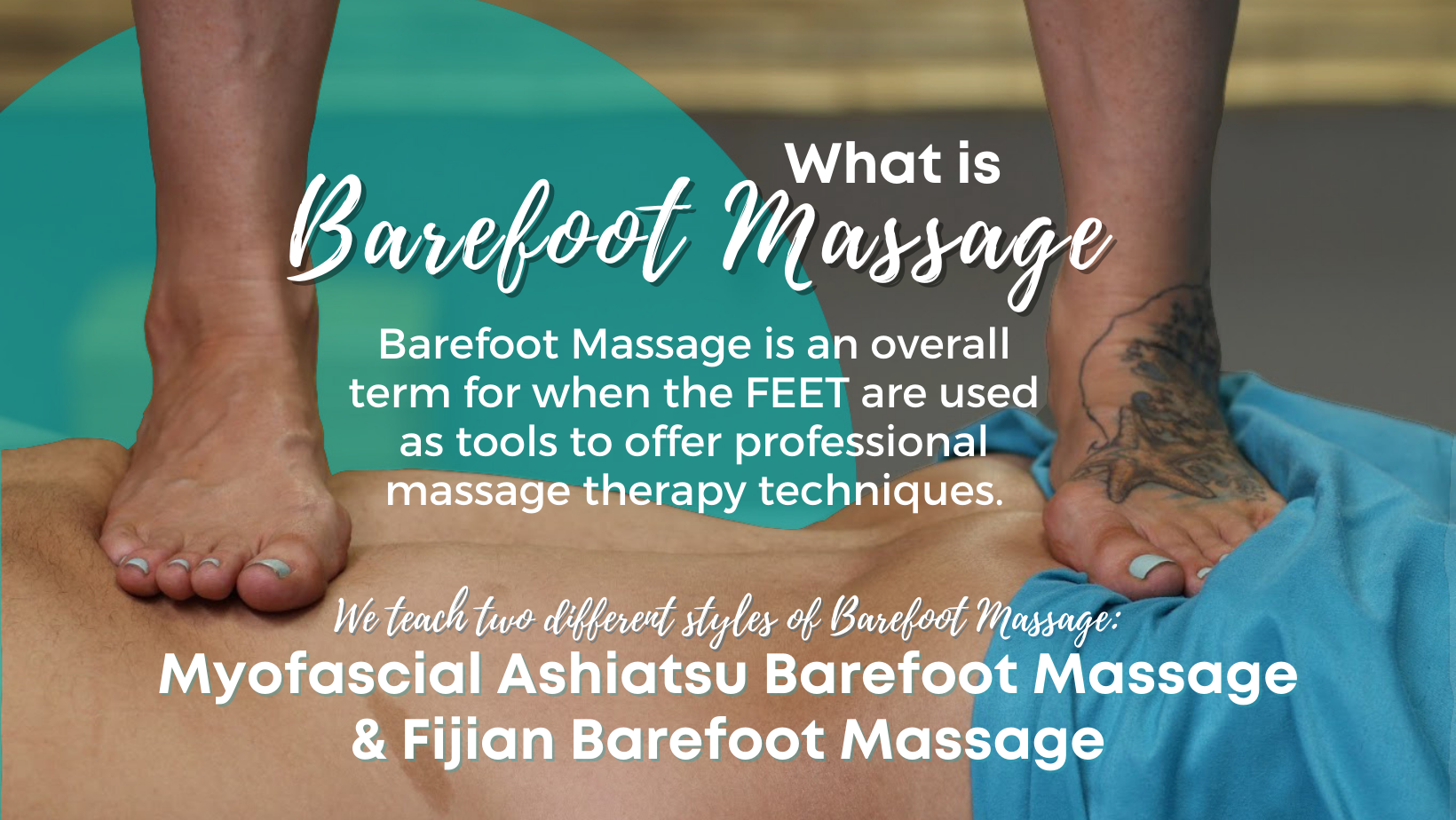Part of our mission here at the Center for Barefoot Massage is not only to cultivate a tribe of smart, educated and informed barefoot massage therapists within the massage industry, but also to educate the public on the benefits of barefoot massage, and what it is. We want to normalize the terminology of “barefoot massage” and make styles within this genre just as recognized and sought after as the typical “sports massage” or “hot stone” massage services are across the nation.
‘The public is just now learning about the difference between a foot massage, reflexology and bare foot massage – and the massage industry is starting to recognize the differences between techniques and styles within the genre.
A trained Barefoot Massage Therapist can use different aspects of their feet to recreate similar sensations that a “Hands-on” massage would deliver. Heels, arches, toes, calves, shins, and knees are employed in various Barefoot Massage techniques, just as fists, palms, fingers, forearms, and elbows are in your average massage from someone’s hands. Similar goals are achieved from each element, but the larger surface area of these tools allows for a diffused, yet distinct pressure that can be less triggering to a person’s pain tolerance.
Just like there are many different styles of massages provided by the upper extremities, there are many different styles of Barefoot Massages.
We teach two different styles of Barefoot Massage: Myofascial Ashiatsu Barefoot Massage – lovingly nicknamed “FasciAshi” (that’s more of an industry term, though. We don’t expect, or really want the public to use that hard-to-pronounce name!) AND we also teach Fijian Barefoot Massage.
Give it weight, then wait is a pretty heavy theory that we’ve found to be important throughout our entire barefoot massage approach to impact the Neuromyofascial web. Working with fascial integration, navigating the contours of muscle and bone while applying broad, consistent pressure on varying angles, the techniques we teach aim to address the body as a functional whole. The further you get into our courses and specialty track classes, the more you’ll see the importance of sustained pressure and anatomical specificity to best impact your client’s interoception.
Here’s our definition of the Myofascial Ashiatsu Barefoot Massage that we teach in any “FasciAshi” class:
This style of work is a modern massage approach to barefoot massage where the Licensed Massage Therapist is specifically using their feet to slowly glide along the skin, addressing muscles and interconnected layers of fascia throughout the body. Additional focused tracks of training help the practitioner to specialize in different niches – offering theories and protocols that use a myofascial massage approach but also add in a deep relaxation vibe, a sports massage vibe, or even a more clinical style for pain/injury rehabilitation.
In order to apply variable angles of weighted pressure through different techniques taught in our series of classes, a Barefoot Massage Therapist trained at the Center for Barefoot Massage will just happen to need overhead bars to hold onto, and a suspended strap to lean back into… in addition to their feet. A portion of the working therapist’s body weight up to their entire body weight can be applied in this technique, based on need, safety, the ratio of weight between the client and therapist, and the professionals level of FasciAshi training.
Here’s our definition of the Fijian Barefoot Massage/Matwork that we teach:
We also teach a neuromuscular sports barefoot matwork massage. Fijian Barefoot Massage gets it’s name from it’s country of origin – and when it was first brought to the US, it was not taught with a Neuromuscular, Trigger Point or a Sports Massage intent – but those are the theories that we layer on top of the technique to give insight into each stroke. It’s a faster-paced form of bodywork where the receiving person wears comfortable clothes and lays in various bolstered positions on a floor cushion or Thai/Shiatsu mat.
The working Barefoot Massage Therapist can sit on a chair, sit on the floor, or stand while applying this technique, and the same suspended strap used in our FasciAshi technique is employed to help offer more confidence in balance and leverage. No overhead bars, no lubricant, and no “back walking” are a part of Fijian Massage – it is an aggressive technique but does not ever utilize the therapist’s full bodyweight.
Barefoot Massage styles include, but are not limited to:
- Shiatsu
- Thai
- Swedish/Deep Tissue Ashiatsu Barefoot Massage
- Myofascial Ashiatsu Barefoot Massage: Nicknamed “FasciAshi” THAT’S US!
- Fijian
- Sarga
- Rossiter
- …and more!
Luckily, we’ve written blog posts on every interpretation of the question – so read these posts, and share the video below with your clients!
- Ashiatsu Barefoot Massage and cultural appropriation
- “Is bare foot massage the same as foot massage?”
- “Is Ashiatsu the same as Barefoot Massage?”
- “Barefoot Massage Therapy Awareness“
- “Is FasciAshi the same as Ashiatsu?”
- “Stretch Therapy meets Ashiatsu Massage”
- Our Texas instructors take on what Barefoot Massage is

